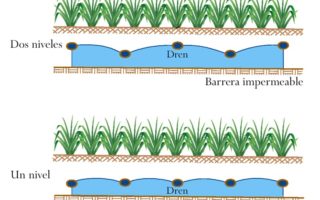Agricultural drainage is defined as the evacuation of excess water in the soil.
The selection of the system to be used at each site should be based on two key factors: recognition and diagnosis of the specific problem.
In the Cauca river valley, approximately 15,000 ha have piped drains installed between 1.6 and 1.8 m deep and spaced between 40 and 100 m. However, on many occasions these drains have not been effective due to the impervious layers above this depth and frequent rainfall.
Sugarcane production decreases by up to 40% as a result of excess humidity that occurs during harvesting in places where the machinery used affects the vines and produces compaction to the soil. Production is also decreased by the same percentage when excess humidity makes it difficult to carry out cultivation practices, directly affecting the regrowth and tillering of the plantation.
Sugarcane production decreases by up to 35 t / ha when the water table remains throughout the crop's growing period at a depth of less than 80 cm.
In order to improve soil moisture conditions to facilitate harvesting, soil preparation, cultural work, and crop development, the alternate drainage system at two depths combined with topo drains was evaluated.
Drainage at two depths
Drainage at two depths Traditionally, to lower the water table, it has been decided to install drain pipes between 1.6 and 1.8 m deep. However, in low permeability soils (0.03-1.5 m / day) these pipes are not as effective and high humidity levels persist on the soil surface.
Drainage at two depths (two levels), with pipe lines placed at two levels alternately, is intended to improve moisture conditions in the soil up to 60 cm deep. It is an alternative for rapid surface drainage in low permeability soils due to the shorter vertical distance that water must travel to reach the surface drain.
Surface drainage
Surface drainage consists of the removal of accumulated water on the land surface due to frequent and intense rains, overflow of channels, flat and irregular topography and soils with low infiltration capacity.
Depending on the origin of the excess water, one or more of the following forms of surface drainage can be chosen for its control:
To control floods. The construction of levees parallel to the channels is recommended to avoid their overflow.
To control runoff waters. The construction of interceptor channels or perimeter dikes to regulate the water coming from adjacent areas gives good results.
Local surface drainage network. It consists of main, secondary and collector channels, which are built within the problem area and have the capacity to remove surface water in a period of 4 to 7 days.
It is also possible to facilitate the drainage of the lots by leveling, in order to form a uniform slope.
Mole drains
They are unlined underground conduits that are built without the need for excavations and help evacuation of excess water from the upper layers of the soil.
This type of drainage is appropriate in areas with clayey soils, high bulk density, little permeability and with an overall slope greater than 0.4%.
The construction of this type of drains requires stable and highly plastic soils, with a minimum of 35% clay and a maximum of 20% sand, and that at the time of work the moisture content in the soil is between 40 % and 80% of its retention capacity.
The fissures that occur each time the mole drains are renewed gradually create a better soil structure and increase its permeability.
The spacing between these drains must be from 2 to 5 m, the depth from 50 to 60 cm, the slope from 0.4% to 4%, the maximum length of 150 m and they must be tubed in the final 2 or 3 m for the discharge Be free and the collector will not deteriorate.

Subsoiler with mole drain














